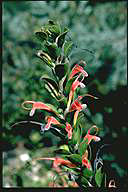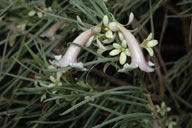

 |
Australian National Botanic Gardens |
 |
A weekly news sheet prepared by a Gardens' volunteer.
Numbers in square brackets [ ] refer to garden bed Sections.
Plants in flower are in bold type.
5 September 2008
 |
Adenanthos obovatus - click for larger image |
Spring most certainly has arrived. Wattles are dazzling throughout our fair city and also in our National Botanic Gardens and many other plants are laden with buds ready to bloom. So, to view the flowers in the Rock Garden starting at the base of the waterfall walking in a clockwise direction a grouping of the small white paper daisy flowers of Rhodanthe anthemoides [Section 15D] between the rocks. In the distance the glow of yellow is that of a wattle, Acacia terminalis [Section 3] so spectacular! Edging the path Banksia integrifolia subsp. integrifolia [Section 15C] is semi- prostrate, dense with silver backed leaves and still with few lemon flower spikes. Opposite, behind another dense shrub Adenanthos obovatus [Section 15D] is quite a small upright plant which reveals its slim red flowers with extended red styles. Dampiera salahae [Section 15D] is quite eye-catching with its vivid blue flowers long short upright stems.
Opposite, in a small bed, Boronia caerulescens [Section 15E] is also a small upright plant bearing many tiny pink four-petalled flowers. Beside is a group of Conostylis candicans subsp. candicans [Section 15E], tufted plants with short strappy leaves and heads of globular yellow flower heads. Behind, Gastrolobium rotundifolium [Section15E] is a rounded shrub dense with small orange pea-shaped flowers in dense terminal clusters. Edging the opposite side path Cryptandra amara var. amara [Section 15B] presents its small tubular starry flowers over its lateral branches.
Grevillea lanigera [Section 15W] is a groundcover dense with bright pink spider flowers. It is being crowded by Acacia pravissima ‘Kuranga Cascade’ [Section 15W] a prostrate shrub clad with small triangular leaves and massed with buds about to open, also falling over the rock wall. Edging this lane, Micromyrtus ciliata [Section 15G] has an attractive coverage of brick red buds now opening to tiny white flowers which then age to a similar shade of red. Returning to the ascending stairs where Westringia glabra [Section 15A] with mauve flowers to highlight the shrub. Homoranthus flavidus [Section 15A] is a flat topped shrub with layers of either yellow or red shaded flowers.
Edging the top road Acacia pravifolia [Section 15H] is a rigid many branched small shrub beautified with its globular yellow flower balls. (Couldn’t help noticing the wattles on the other side of the road). Olearia astroloba [Section 15H] has its mauve daisy-like flowers atop upright branches while Cryptandra sp. [Section 15h] is low and spreading clad with tiny cream flowers.
 |
Eremophila oppositifolia - click for larger image |
Opposite the downward stairs, the Cootamundra Wattle, Acacia purpurea [Section 3] is splendid with its coverage of yellow fluffy flower balls amongst its bluish foliage. At the bottom of these stairs Leucopogon fraseri [Section 15K] is a low spreading plant attractive with red foliage and tiny red tubular flowers. Cauliflower Hakea, Hakea corymbosa [Section 15P] is still interesting with few clusters of lemon-green flower spikes mixing with the sharp pointed narrow leaves. Edging this downward path are Hardenbergia ‘Mini Haha’ [Section 15S] which reveals its purple pea-shaped flowers over the entangled vine, Acacia gittinsii [Section 15S] with its low wandering branches terminating with its golden flower balls. Correa pulchella [Section 15S], beside the path, shows off its soft pink tubular flowers and at the corner, the ever flowering Thryptomene denticulata [Section 15S] covers its arching branches with its tiny pink flowers while behind, Leucopogon melaleucoides [Section 15S] covers the dwarf shrub with tiny white frilly flowers.
In front of the waterfall the small garden contains numerous emu bushes including Eremophila oppositifolia [Section 15V] an upright shrub with cream tubular flowers and Eremophila dalyana [Section 15V], also with fine leaves soft pink tubular flowers.
A really interesting place … Barbara Daly.